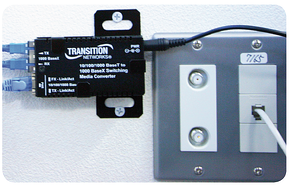Transition Networks media converters are designed for a number of scenarios, with specifications including power over Ethernet (PoE), extended temperature ranges, industry-required certifications and remote management. Partnering with Accu-Tech will provide you with excellent service throughout the life of your fiber integration project and a lifetime warranty on the Transition Networks products in your network.
Transition Networks FTTD solutions, or fiber-to-the-desktop solutions, were utilized in a complete renovation of the LAN systems at the National University Corporation Gunma University’s Aramaki Campus in March 2010.
“After looking at examples of other universities that adopted a shared fiber optic network, I understood these were excellent networks... thinking long term, the LAN also needed to be restructured in [a] way that handles the demand for future speed increases. A FTTD infrastructure can be adapted to speed increases just by changing the devices used, so this was the network we decided to introduce for the benefit of our students and the benefit of our network," Associate Professor Ueda explained.
In the last 10 years, the speed of the network that a terminal can use has gone from 100Mbps to 1 Gbps, a 10x increase in data traffic. To accommodate for the increase in traffic, and expect further increases in the future, education systems across the globe are starting to upgrade to FTTD systems. A future-proofed cabling infrastructure is one of the strongest reasons to introduce FTTD to the system.

There are many benefits of an FTTD infrastructure. For the Gunma campus, one of the most impactful benefits was the easy-to-use nature of the network.
Associate Professor Ueda explained: "Wherever you are in the campus, you can access and use the printer in your own room simply by plugging in a LAN cable. This is extremely convenient. In a university like ours, a single department may sometimes use rooms in several different buildings and the inconvenience of returning to one's office to print is now removed."
Other benefits of the system include the space saving design, rate conversion from 10/100/1000Base-T devices to 1 Gig Ethernet network, auto-negotiation, link pass through and automatic link restoration.
To read the full case study on the National University Corporation Gunma University’s use of FTTD, click here.



.png?width=58&height=58&name=X_logo_2023_(white).png)
